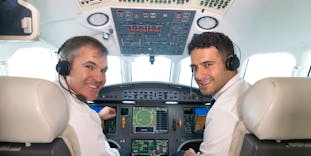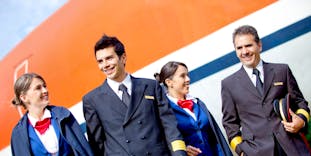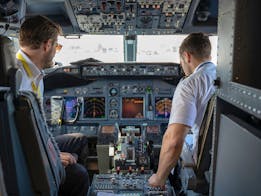How to Become a Flight Attendant – Process & Job Role
Updated November 20, 2023
- What Does a Flight Attendant Do?
empty
empty
empty
empty
empty
empty
- Key Requirements for Becoming a Flight Attendant
empty
empty
empty
empty
empty
empty
- How to Be a Flight Attendant: Key Skills and Attributes
empty
empty
empty
empty
empty
- How Do You Become a Flight Attendant?
- What Are the Job Prospects for Flight Attendants?
empty
- Frequently Asked Questions
- Final Thoughts
To become a flight attendant, you’ll need to meet the minimum requirements set by your chosen airline, which typically include a high school diploma or GED.
On passing background and eligibility checks, you’ll be enrolled in a flight attendant training program where you’ll receive the required qualifications to become a certified flight attendant.
A career as a flight attendant can be an exciting prospect for many, offering travel opportunities and the chance to engage with a diverse group of people.
As such, it’s a competitive field, and you’ll need to stand out from the crowd to secure yourself a position.
To help you, this article tells you all you need to know about how to become a flight attendant.
What Does a Flight Attendant Do?
A flight attendant, also referred to as an in-flight attendant or cabin crew member, plays a vital role in ensuring passengers' safety, comfort and overall well-being during a flight.
The exact responsibilities of a flight attendant can vary depending on the airline and the aircraft type.
Still, there are some common duties every flight attendant can expect to undertake as standard:
Cabin Preparation
Before each flight, flight attendants ensure the cabin is clean, well-stocked with supplies and properly configured for passenger comfort and safety.
They also conduct pre-flight checks of emergency equipment and cabin systems.
Safety Procedures
Flight attendants are responsible for conducting pre-flight safety briefings and demonstrations, including explaining the use of safety equipment such as seat belts, oxygen masks and life vests.
During the flight, flight attendants monitor passengers for compliance with safety regulations and assist in emergencies, such as evacuations, if necessary.
Customer Service
Flight attendants provide customer service by assisting passengers with seating, helping them stow carry-on baggage and attending to their needs throughout the flight.
They offer food, beverages and in-flight entertainment options, taking into account passengers' dietary restrictions and preferences.
Emergency Response
Flight attendants are trained to handle various emergencies, such as medical incidents, turbulence or security threats.
They are responsible for administering first aid when needed, assisting passengers in distress and maintaining communication with the flight deck.
Security
Flight attendants play a role in maintaining the security of the aircraft by monitoring passenger behavior and reporting any suspicious activity to the flight crew.
They may also assist with security protocols, such as passenger screenings.
Communication and Administration
Flight attendants are a vital communication link between the passengers and the flight deck crew.
They relay important information, including weather updates, flight progress and any changes to the itinerary.
Flight attendants also carry out administrative duties, completing paperwork and reports related to the flight, such as documenting incidents, passenger counts and inventory of in-flight supplies.
Prepare for Your Airline Aptitude Test with JobTestPrep
Key Requirements for Becoming a Flight Attendant
The specific requirements for becoming a flight attendant can vary from one airline to another.
Still, there are some common qualifications and prerequisites that most airlines look for in potential candidates, including the following:
Education
Most airlines require a high school diploma or equivalent (such as a GED).
Some may prefer or require candidates to have completed some college coursework or have a college degree, although this is not always mandatory.
Age
Airlines typically have minimum and maximum age requirements for becoming a flight attendant.
The minimum age is usually 18 to 21 years old. The maximum age can vary but is often around 35 to 40 years old, though it can be higher for some airlines.
Legal Right To Work
Candidates must have legal authorization to work in the country where the airline is based. This means being a US citizen or having the appropriate work visa or green card in the US.
Passport and Travel Documents
You must have a valid passport and any necessary travel documents to operate on international routes.
Physical Requirements
Depending on the airline, you may need to meet certain physical requirements, such as a specific height-to-reach ratio, to perform duties like reaching overhead bins and operating emergency equipment.
Good vision is also a prerequisite.
Appearance
Many airlines also have specific appearance guidelines, such as restrictions on visible tattoos and body piercings.
In addition to the above flight attendant requirements, airlines usually ask candidates to undergo pre-employment drug testing as part of their screening process.
This drug test ensures that candidates are not using illegal substances or prescription medications that could impair their ability to perform their duties safely. It is typically conducted alongside a criminal background check.
How to Be a Flight Attendant: Key Skills and Attributes
As well as meeting the basic requirements, there are specific skills and attributes you’ll need to possess if you’re thinking of becoming a flight attendant.
These include:
Communication Skills
- Clear verbal communication to relay safety instructions and information
- Active listening to understand passenger needs and concerns
- Non-verbal communication, such as body language and facial expressions, to convey professionalism and approachability
Customer Service
- Empathy and patience to handle diverse passenger personalities and needs
- Problem-solving abilities to address passenger complaints and issues effectively
- Attention to detail to provide personalized service and meet passenger requests
Adaptability and Flexibility
- The ability to adjust to different time zones and work irregular hours
- Staying calm and composed in high-stress situations, such as turbulence or medical emergencies
- Quickly adapting to new environments and aircraft configurations
Physical Fitness and Stamina
- Good overall health and fitness to meet airline standards.
- Stamina and endurance to handle long flights and irregular sleep patterns.
- The ability to assist passengers with mobility issues and carry out emergency procedures.
Teamwork and Collaboration
- Collaboration skills to coordinate tasks and responsibilities
- The ability to follow strict protocols and procedures
- A positive attitude and willingness to support colleagues in various situations
There are no specific prerequisites for subjects needed to become a flight attendant. Still, a background in hospitality, tourism or customer service-related subjects can be a significant advantage.
Multilingual skills are also beneficial, particularly for airlines that operate international routes.

If you need to prepare for a number of different employment tests and want to outsmart the competition, choose a Premium Membership from JobTestPrep.
You will get access to three PrepPacks of your choice, from a database that covers all the major test providers and employers and tailored profession packs.
How Do You Become a Flight Attendant?
Now we’ve covered the key requirements, skills and attributes, let's look specifically at how to become a flight attendant and the steps you’ll need to take.
Step 1. Find a Flight Attendant Training Program
To start your journey toward becoming a flight attendant, you'll need to find and apply for a recognized training program.
Many US airlines offer these and provide a direct route to permanent employment upon completion.
Popular airlines that offer flight attendant training programs include:
- American Airlines
- Delta Air Lines
- United Airlines
- JetBlue
- Alaska Airlines
Keep an eye on official airline websites and job boards for openings. Airlines often hire trainee flight attendants in cycles, so applying when positions become available is important.
Alternatively, you could apply to a training institute like The Travel Academy or The Airline Academy or take a flight attendant degree at a college or university.
Step 2. Complete Your Application
Once you’ve found a program of interest, you must complete your flight attendant application.
If you apply directly to an airline, each will have its own recruitment process. That said, you can reasonably expect to go through the following stages:
Online application
Start by submitting your resume and a cover letter through the airline's website or designated application portal.
Ensure your resume highlights relevant experience in customer service, hospitality or related fields.
Pre-Employment Testing
Airlines often require candidates to take pre-employment tests. These tests may include
- Personality assessments – Airlines want to assess your suitability for the role, focusing on traits like teamwork, adaptability and customer orientation
- Verbal reasoning – This test evaluates your ability to understand and work with written information, which is essential for interpreting safety manuals and communicating with passengers
- Situational judgment – You'll be presented with various scenarios to assess your ability to make sound decisions and handle challenging situations effectively
The exact tests you’re asked to take will vary by airline.
For example, Delta Air Lines has several tests it administers as part of its recruitment process.
-
First stage interview – If your application passes the initial screening, you may be invited for a phone or video interview. Be prepared to discuss your qualifications, motivation for becoming a flight attendant and availability.
-
Final interview – This is typically the last stage of the airline's selection process. During the final interview, you'll meet with airline representatives in person or virtually. Expect questions about your experience and your enthusiasm for the role.
Step 3. Complete Your Training
Once you've successfully cleared the application process, you'll enter the next phase – flight attendant training.
These programs typically last four to eight weeks, depending on the airline.
During this time, you'll be provided with intensive classroom instruction and hands-on training in a range of topics, including:
- Safety procedures, such as evacuations and emergency equipment usage
- In-flight service, including serving meals and beverages
- Customer service skills, conflict resolution and communication techniques
- Medical emergency response and basic first aid
- Cultural sensitivity and diversity training
You'll participate in practical exercises, including mock evacuations, emergency drills and in-flight service simulations.
Successful completion of the training program requires passing final exams, which typically include both written and practical assessments.
Step 4. Achieve FAA Certification
After completing your airline's training program, you'll need to obtain certification from the Federal Aviation Administration (FAA).
The specific certification you'll need is the Certificate of Demonstrated Proficiency.
This confirms that you've successfully completed the required training and is a crucial step to becoming a flight attendant, as it allows you to legally perform your duties on commercial flights.
Once you're certified, you typically secure a job with your training airline. However, you can apply to different airlines later if you wish.
To maintain your status as a certified flight attendant, you’ll need to renew your FAA certification annually.
It’s also worth noting that there are different certifications for different types of aircraft, so you may need to obtain a new one if you switch airlines and/or the aircraft type you work abroad.
What Are the Job Prospects for Flight Attendants?
As an aspiring flight attendant, you can be relatively optimistic about your career prospects.
According to the US Bureau of Labor Statistics (BLS), employment in the field is growing faster than the average rate, in large part due to recovery in the travel industry post-pandemic.
Do keep in mind, however, that demand for new flight attendants is subject to various external factors like travel industry trends and economic conditions.
In terms of progression, you could look to pursue leadership roles like Senior Flight Attendant or specialize in a particular area of aviation.
For example, you could become a corporate flight attendant working on private jets or focus on training new flight attendants.
Average Flight Attendant Salary
Pay data from the BLS gives a median flight attendant salary of $61,640, with the top 10% earning upwards of $81,400.
When looking at the salary associated with any flight attendant role, remember to consider the compensation package as a whole.
This is likely to include an expense allowance and benefits such as discounted travel and 401(k) contributions.
Frequently Asked Questions
Becoming a flight attendant is a multi-stage process that involves education, training and certification.
A background in subjects like tourism, hospitality or customer service will increase your chances of being accepted onto a flight attendant training program, where you’ll receive practical and classroom instruction.
On completion of your training, you’ll achieve FAA certification, qualifying you to work on commercial flights.
Provided you meet the basic requirements in terms of age, physicality and the right to work, no prior experience is needed to become a flight attendant.
You can apply to an airline for an entry-level position and receive all the training required to start your career.
However, you will need to make your application stand out in a competitive market.
Be sure to research how to be a flight attendant and highlight all the relevant skills and qualities that demonstrate your suitability for the role throughout the application and interview process.
Currently, the average flight attendant salary in the US is $61,640.
It should be noted that salaries do vary across airlines and base locations. Your experience will also impact how much you can reasonably expect to be paid.
Becoming a flight attendant can be challenging due to the competitive nature of the job market.
Airlines often receive a high volume of applications, making it crucial to stand out during the selection process.
Be sure to tailor your resume and cover letter for each application, highlighting the key skills and attributes that prove you're a good fit for the role.
You should also prepare for any pre-employment testing by taking plenty of practice aptitude tests and brush up on your interview skills.
The duration of flight attendant school typically ranges from three to eight weeks, depending on the airline and the specific training program.
These intensive programs cover a wide range of topics, including safety procedures, emergency protocols, customer service and airline-specific policies.
The minimum age requirement for becoming a flight attendant in the US is typically 20 to 21 years old. However, some airlines will accept candidates at 18 years of age.
Before you submit your flight attendant application, check with the airline you're interested in to confirm their specific age criteria.
Height requirements for flight attendants are not as strict as they used to be as the industry looks to promote diversity and inclusivity.
However, you will need to be able to comfortably perform essential duties aboard the aircraft, like reaching overhead bins and assisting passengers.
For this reason, some airlines may still have a minimum height requirement, often around 4'11". For specific details, check with your preferred airline.
Final Thoughts
Becoming a flight attendant is a great career choice if you have a passion for travel and customer service.
However, it is a competitive industry, and you’ll need to present yourself as an ideal candidate to succeed.
Crafting a well-researched application, taking pre-employment practice tests and brushing up on your interview skills will help you here.
Provided the responsibilities of the role align with your skills, interests and professional goals, you stand every chance of securing a position with a commercial airline and enjoying a fulfilling career as a flight attendant.






